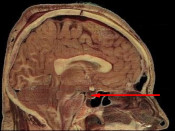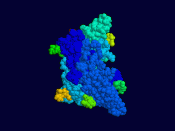Sperm Travel Essay
When puberty begins in a male, the hypothalamus starts to produce a few different kinds of hormones that interact with the pituitary gland, which influences many physiological processes of the body. The hypothalamus then secretes a hormone that causes the pituitary gland to release other hormones. Those other two hormones are called Follicle Stimulating Hormone (FSH) and Luteinizing Hormone (LH). After FSH and LH are released into the bloodstream, they are sent to the testes where FSH starts the production of sperm and LH causes endocrine cells to start producing testosterone, which also influences the production of sperm. The productions of these hormones are controlled by a negative feedback system. If testosterone levels are high, the production of FSH and LH are reduced. If testosterone levels are low, FSH and LH production is increased.
In females the same FSH and LH hormones are produced, except in females FSH starts the development of follicles.
Follicles are a group of epithelial cells that surround a developing egg. FSH also causes the production of estrogen in females.
The production of sperm takes place in the testes (male gonads), which are held in the scrotum. The scrotum is located behind the base of the penis, and according to the temperature, the muscles in the wall of the scrotum contract or expand to keep the temperature right for the production of sperm. Sperm are produced by meiosis in the coiled tubes of the testes, called seminiferous tubules, at a rate of around three hundred million a day. The mitochondria located behind the head of the sperm provide the power for the sperm to move. The head of the sperm contains the nucleus and is covered with a cap of enzymes, which allow the sperm to get into the egg.
When the sperm are ready to leave the testes, they move into he epididymis where they are stored and complete their maturation. When the sperm are released from the epididymis, they are pushed through a tubular duct, called the vas deferens, where peristaltic contractions force the sperm to the ejaculatory ducts and urethra. The urethra also transports urine from the bladder. A muscle at the base of the bladder keeps the sperm and urine from mixing. Along the path of the sperm are three glands which aide in the mobilization and protection of the sperm. The first of these three glands is the seminal vesicle, which secretes a fluid rich in sugar fructose to provide energy for the sperm. The next gland the sperm encounter is the prostate gland. The prostate secretes a thin alkaline fluid to help the sperm move and survive. The last pair of glands the sperm run into are the bulbourethral, or Cowpers, glands. These glands give out a clear sticky fluid that neutralizes the acidic environment of the vagina. The combination of these three fluids combined with the sperm is called semen.
The female's part in reproduction is to produce eggs and provide an environment for a fertilized egg to develop. The production of eggs occurs in the ovaries (female gonads). The egg is transported by the oviducts (or fallopian tubes) to the uterus where if the egg is fertilized, implantation fill occur. Egg production occurs even before the female is born. After about two million eggs, which at this time are called primary oocytes, are produced, they enter a resting stage. By the time a female reaches puberty, there are about 40,000 primary oocytes left. Beginning at puberty, one egg is released a month and goes through meiosis one and two. The egg then ruptures from the ovary and is transported to the oviduct. This monthly process is called ovulation. Once the egg is released, the part of the follicle that is left in the ovary develops into a corpus luteum, which secretes estrogen and progesterone. Progesterone causes certain changes to occur in the lining of the uterus in preparation of receiving a fertilized egg.
For fertilization of the egg to occur, the sperm must be present in the oviduct after the first few hours of ovulation. After the sperm swim up the vagina, through the cervix and uterus, they reach the oviducts and find the egg. After a sperm enters the egg, no other sperm can get in and it is referred to as a zygote.
After the sperm and egg combine to form a zygote, the zygote goes down through them oviduct and into the uterus where it then becomes a blastocyst. The blastocyst then goes through implantation where it attaches to the uterine lining and soon becomes an embryo.
The amnion is a thin membrane that is filled with amniotic fluid that absorbs some shock and regulates the body temperature of the embryo. The chorion is a membrane that surrounds the amniotic sac and embryo. About two weeks after fertilization, chorionic villi begin to from off of the chorion and grow into the uterine wall, which then forms the placenta. The placenta is what delivers nutrients to the embryo. By the eighth week of pregnancy, the embryo is referred to as a fetus. Most of the fetus's body growth occurs in the second trimester. The fetus starts to move around the seventh month, and its eyes open around the eighth month. The baby is soon born.



Eeewwwww!
just kidding! very informative and well done!
2 out of 3 people found this comment useful.